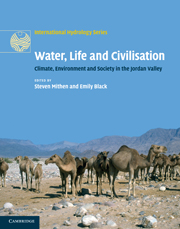Book contents
- Frontmatter
- Contents
- List of figures
- List of tables
- List of contributors
- Acknowledgements
- 1 Introduction: an interdisciplinary approach to Water, Life and Civilisation
- Part I Past, present and future climate
- Part II The palaeoenvironmental record
- Part III Hydrological studies of the Jordan Valley
- Part IV Human settlement, climate change, hydrology and water management
- 14 The archaeology of water management in the Jordan Valley from the Epipalaeolithic to the Nabataean, 21,000 BP (19,000 BC) to AD 106
- 15 From global climate change to local impact in Wadi Faynan, southern Jordan: ten millennia of human settlement in its hydrological context
- 16 Palaeoenvironmental reconstruction at Beidha, southern Jordan (c. 18,000–8,500 BP): Implications for human occupation during the Natufian and Pre-Pottery Neolithic
- 17 The influence of water on Chalcolithic and Early Bronze Age settlement patterns in the southern Levant
- 18 Modelling water resources and climate change at the Bronze Age site of Jawa in northern Jordan: a new approach utilising stochastic simulation techniques
- 19 A millennium of rainfall, settlement and water management at Humayma, southern Jordan, c. 2,050–1,150 BP (100 BC to AD 800)
- Part V Palaeoeconomies and developing archaeological methodologies
- Part VI Society, economy and water today
- Part VII Conclusions
- Index
- Plate section
- References
15 - From global climate change to local impact in Wadi Faynan, southern Jordan: ten millennia of human settlement in its hydrological context
from Part IV - Human settlement, climate change, hydrology and water management
Published online by Cambridge University Press: 26 April 2011
- Frontmatter
- Contents
- List of figures
- List of tables
- List of contributors
- Acknowledgements
- 1 Introduction: an interdisciplinary approach to Water, Life and Civilisation
- Part I Past, present and future climate
- Part II The palaeoenvironmental record
- Part III Hydrological studies of the Jordan Valley
- Part IV Human settlement, climate change, hydrology and water management
- 14 The archaeology of water management in the Jordan Valley from the Epipalaeolithic to the Nabataean, 21,000 BP (19,000 BC) to AD 106
- 15 From global climate change to local impact in Wadi Faynan, southern Jordan: ten millennia of human settlement in its hydrological context
- 16 Palaeoenvironmental reconstruction at Beidha, southern Jordan (c. 18,000–8,500 BP): Implications for human occupation during the Natufian and Pre-Pottery Neolithic
- 17 The influence of water on Chalcolithic and Early Bronze Age settlement patterns in the southern Levant
- 18 Modelling water resources and climate change at the Bronze Age site of Jawa in northern Jordan: a new approach utilising stochastic simulation techniques
- 19 A millennium of rainfall, settlement and water management at Humayma, southern Jordan, c. 2,050–1,150 BP (100 BC to AD 800)
- Part V Palaeoeconomies and developing archaeological methodologies
- Part VI Society, economy and water today
- Part VII Conclusions
- Index
- Plate section
- References
Summary
ABSTRACT
Wadi Faynan, southern Jordan, provides an archaeological record of human settlement from the Lower Palaeolithic to the Islamic period, and indeed into the present day. As for any long-term record of settlement, an understanding of the changes in economy and society requires knowledge about the impacts of climate and environment change on human communities, especially when dealing with settlement in arid landscapes. This chapter attempts to place the 10,000 years of Holocene settlement in Wadi Faynan between c. 12,000 and 2,000 years ago into its hydrological context. A rainfall-runoff model is used to examine the potential impacts of both Holocene climatic change and human behaviour on the hydrological behaviour of the wadi and then on human settlement. Wade et al. (this volume, Chapter 12) have shown that rainfall-runoff models can successfully simulate the behaviour of the present-day wadi system, demonstrating how such behaviour is sensitive to variability in rainfall and infiltration rates. Here we use the results of regional climate modelling to determine statistical properties of palaeo-rainfall for the Wadi Faynan and then use a stochastic weather generator (this volume, Chapter 5) to create a rainfall series which is used to drive the hydrological model. Results are used to explore the potential impacts of climatic variability on human communities from 12,000 to 2,000 years ago, demonstrating that palaeohydrology may provide a bridge between regional-scale climate data and local-scale cultural developments.
- Type
- Chapter
- Information
- Water, Life and CivilisationClimate, Environment and Society in the Jordan Valley, pp. 218 - 244Publisher: Cambridge University PressPrint publication year: 2011
References
- 2
- Cited by



